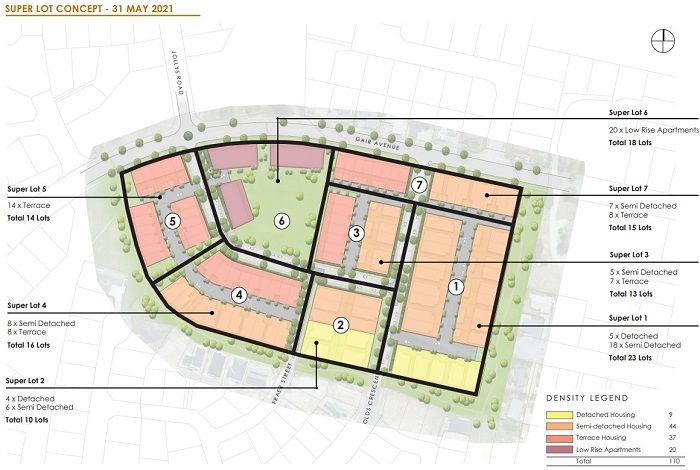Council changes tack on housing plan
Jill Herron
08 August 2022, 5:45 PM
 A mix of housing types is planned for the final stage of the council-owned Gair Avenue subdivision in Cromwell
A mix of housing types is planned for the final stage of the council-owned Gair Avenue subdivision in CromwellThe Central Otago District Council (CODC) has ditched plans to partner-up with a developer to complete its housing subdivision at Gair Avenue in Cromwell.
New styles of housing are proposed for what is now a go-it-alone development, aimed at providing affordable options for home buyers, CODC property and facilities manager Garreth Robinson told the The Central App.
The desire to make home ownership more accessible, as well as confidence gained from earlier stages undertaken in a 50:50 arrangement with an experienced developer, has prompted the move.
The mix of 110 apartments and stand-alone, semi-detached and terraced houses could net between $6M and $10M for ratepayers, as well as crack open the door to more buyers.
The figure, which Garreth described as “a very rough estimate in a very dynamic market”, follows a profit for council from the previous development stage of just under $10M.
The rather lengthy time frame of completion in five years was due to council having to test the market and partially finance the work as it went. Semi-detached houses would be sold ‘off the plans’ pre-construction. This meant titles would not be issued until enough demand was evident to proceed.
The apartment buildings would also require more complicated consenting work through council’s District Plan.
While it was impossible to estimate prices at this very early stage, council was confident buyers could expect options that would allow them to pay considerably less than current offerings.
The subdivision has been sectioned into five lots, each with a slightly different style of dwelling.
The first stage would match the stand-alone housing of the existing development and Garreth said he hoped these would be taken up fairly quickly to help seed funds for the next stage.

CODC’s proposal for the final stage of the Gair Avenue subdivision
Construction work is set to begin late next year with the first titles being issued around autumn 2024.
“Once the design for the semi-detached and terraced houses are completed, council will run a tender for an estate agent to market the property. Stage 1 will go on the market first for nine detached lots and the two additional concept designs (semi-detached and terraced houses) will be sold off plan.”
Garreth said council had shown it was capable of undertaking the work and had learnt a lot through previous projects including a successful industrial subdivision on Cemetery Road.
Documents show that partnering with a developer had been favoured for the first part of the Gair Avenue development to avoid council taking on the “full commercial risk” and staff being saddled with a too-heavy workload.
In Alexandra council’s Dunstan Park housing development is being completed through a partnership, with the Cromwell venture being a first for the local body.
“We’ve proven ourselves with Cemetery Road. We now have the skill set to do it.”
The Gair Avenue plot was formerly a pine plantation and Garreth was not aware of any other previous land uses or water or soil issues at the site.
It sits lower than surrounding land and often holds water after rain prompting speculation from observers that drainage issues could be present.
Garreth said CODC would endeavour to use local contractors as much as possible. This had not always happened in the past and companies from outside Central Otago were used for the completed Gair Avenue subdivision and at Dunstan Park in Alexandra.
Details around the council’s subdivision developments over past years had been largely kept out of the public domain with the Cromwell Community Board citing commercial sensitivity as the necessity for holding all discussions on Gair Avenue in closed meetings.
CODC planning and environment executive manager Louise van de Voort earlier told the Central App that if council had elected to sell the Gair Avenue land to a developer rather than partner with one and undertake the subdivision, it would have made less than half of the gains from the first stage of the Gair Avenue project.
Having an experienced developer on board had also reduced risk factors for the council in undertaking such a venture.
The upcoming mixed-type housing development aimed to deliver on Cromwell’s aspirations to intensify development within the existing town boundaries, as outlined in its new Spatial Plan document, she said.
The Spatial Plan is part of Cromwell’s wider master planning exercise which also covers industrial development and protects areas considered to be valued for recreation and aesthetics.
Cromwell spend over $73M
The gains will be welcome to help offset a considerable spend-up in the town, mostly on long-awaited projects.
Plans are being finalised for the $16M cultural centre off Melmore Terrace which will also boast a new $6M museum.
These projects come with the tidy additional sum of $9.5M for project management, site preparation and landscaping.
A group had earlier proposed developing the cultural centre as a predominantly community-led project, sourcing funds from grants and other sources as well as council.
Meanwhile in the Clyde-Dam-era shopping mall, Wellington architects are creating a new vision for what many consider a very dated feature of the town.
The budget holds $13.5M for that project plus $5.5M for a new resource centre. A further $12.3M was tagged for a possible new council service centre and $11M for a new library, according to council documents.



